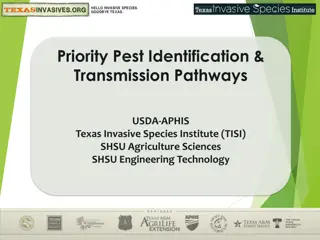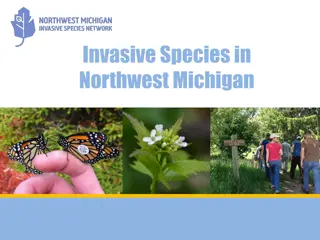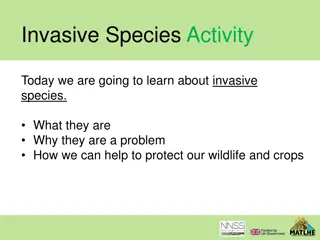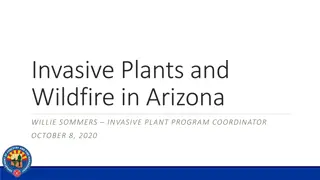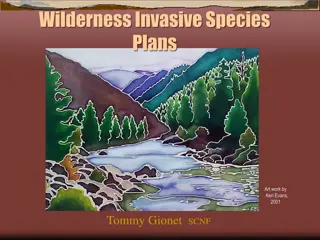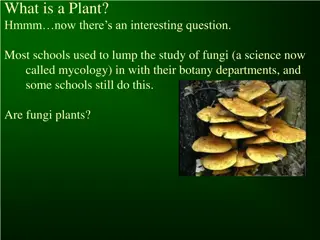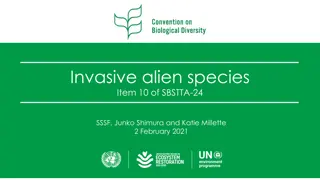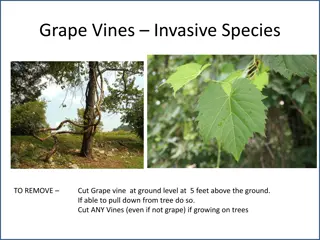
Addressing Invasive Plants Threat in California and New England
California Invasive Plants Council (Cal-IPC) and Eastern Native Plant Society work to combat invasive plants threatening ecosystems in California and New England. Cal-IPC focuses on assessment, restoration, research, education, and policy advocacy, while the Eastern Native Plant Society targets identification, eradication, restoration, and education on invasive plants in New England.
Download Presentation

Please find below an Image/Link to download the presentation.
The content on the website is provided AS IS for your information and personal use only. It may not be sold, licensed, or shared on other websites without obtaining consent from the author. If you encounter any issues during the download, it is possible that the publisher has removed the file from their server.
You are allowed to download the files provided on this website for personal or commercial use, subject to the condition that they are used lawfully. All files are the property of their respective owners.
The content on the website is provided AS IS for your information and personal use only. It may not be sold, licensed, or shared on other websites without obtaining consent from the author.
E N D
Presentation Transcript
MPA 430 Hypothetical Nonprofit
Model California Invasive Plants Council Cal-IPC formed in 1992 to address one of California s top environmental threats. We work closely with agencies, industry and other nonprofit organizations. Our active membership includes public and private land managers, ecological consultants and researchers, planners, volunteer stewards, and concerned citizens. Allied invasive plant councils exist in many other states, though Cal-IPC has the largest membership.
Issue Invasive Plants and Native Species Nonnative plants crowd out native plants Destroy ecosystems Famous example Kudzu in south In Connecticut, Barberry, Japanese Knotweed, Bamboo Planted as ornamentals, spread out of control
Programs Assess impacts of invasive plants Support restoration workers Support research Promote public education Advocate for policy initiatives Reduce invasive plant introductions through horticulture Works with nurseries to discourage use of invasives
Finances Revenue - $695,900 Program service revenue: $145,000 Expenses - $656,600 Salaries: $332 m Fundraising: $19,000 Net Assets: $337,000 Financials are NOT audited
Transparency Transparency Included on Webpage Directors and staff Financial Statements No donor privacy policy on webpage Other CN requirements are on form 990, for the most part
Viability of Programs and Finances Viability of Programs and Finances Extent of programs may reduce effectiveness Although all are important Fee income provides complementary source of revenue Income is growing Programs are somewhat unique most nonprofits that do this are focused on aquatic invasives
The Eastern Native Plant Society The Eastern Native Plant Society Focus: Identification and eradication of invasive plants in New England Restoration of native plants Education of growers and homeowners on the negatives of choosing invasive plants
Mission Statement: The Eastern Native Plant Society, working with other concerned groups and individuals, works to eliminate destructive invasive plants from natural habitats, and re- introduce native species. To this end, we educate on what plants are destructive to local environments, we work to reclaim lands that have been overcome with invasives, and we provide advocate for protective legislation at the state and federal level
Management Structure Management Structure Jason Plante, President and CEO Day-to-day management Christina Vine, CFO Staff: Grants writer Field Supervisor Communications Director Volunteers Network of volunteers that assist in educational mission, eradication programs, replanting programs
Oversight Oversight Independent Voting Board Drawn from municipal representatives (public works, parks and recreation), nurseries and local community colleges Standard regulation by IRS
How we Serve our Stakeholders Donors Effective use of donations through leveraging fees and memberships raise effectiveness Granting Agencies Annual reporting of outputs/impacts to both agency and public Community Restoration of parks, nature trails, public Spaces Staff Management team aims to include staff in decision-making
Programs Programs Identification of invasives and eradication Fee for Service Works with local municipalities in New England to identify invasive plants and design an eradication program Reintroduction of original species when practical Fee for Service Education and Advocacy for the elimination of invasives Nursery Program Work with nurseries to avoid sale of invasive plants
Financials Financials Sources of Revenue State and local grants: Donations Fees (eradication and replanting) Membership dues Sale of educational materials $380,000 $150,000 $220,000 $ 50,000 $ 20,000 Total $820,000
Expenses Management and Fundraising Eradication programs Replanting Educational materials and advocacy $210,000 $320,000 $225,000 $ 50,000 Total $805,000 Net Revenue Over Expenses $ 15,000
Parallel Government Programs Parallel Government Programs Bureau of Land Management Invasive Plants National Invasive Species Information Management System Collects data on invasives Document About Weeds and Invasives Works with 8 states (those with national parks, in particular) to reduce the spread of invasives State Connecticut Invasive plant working group Managed by Uconn, Invasive Plants Council. Sec. 22a-381b USDA also publishes list of noxious plants
Nonprofit v. Government Programs Nonprofit v. Government Programs Government focuses primarily on education, except BLM activities in western states Nonprofit complements by providing in-field services, direct contact education programs, etc.



